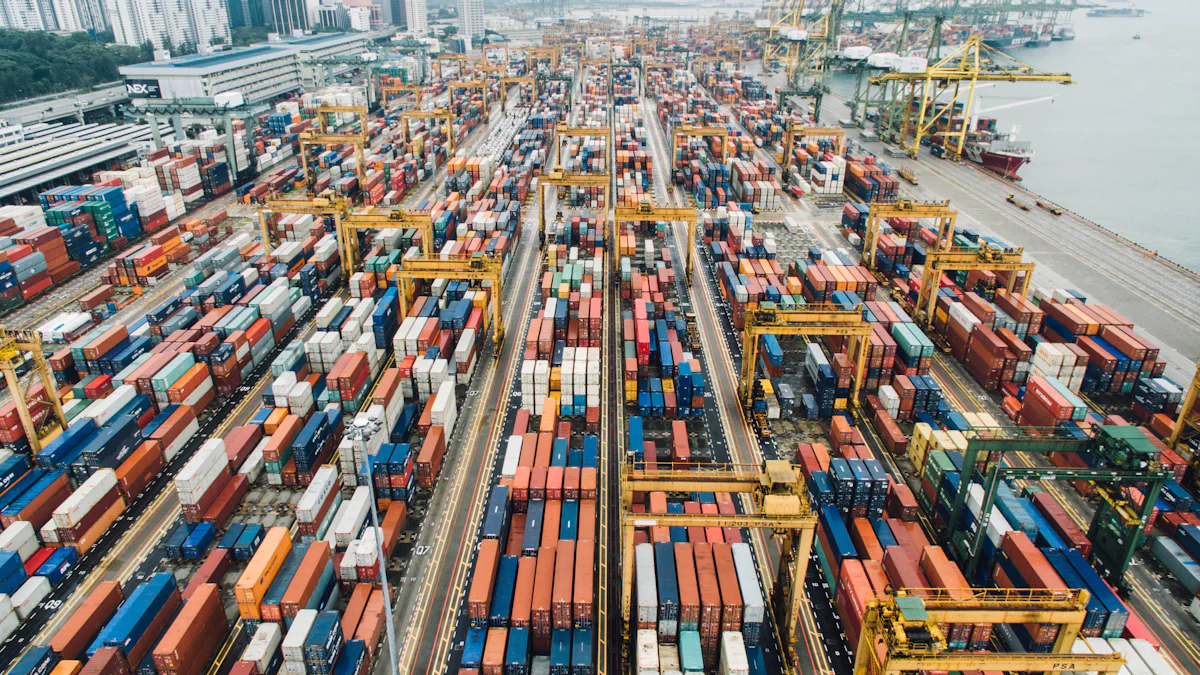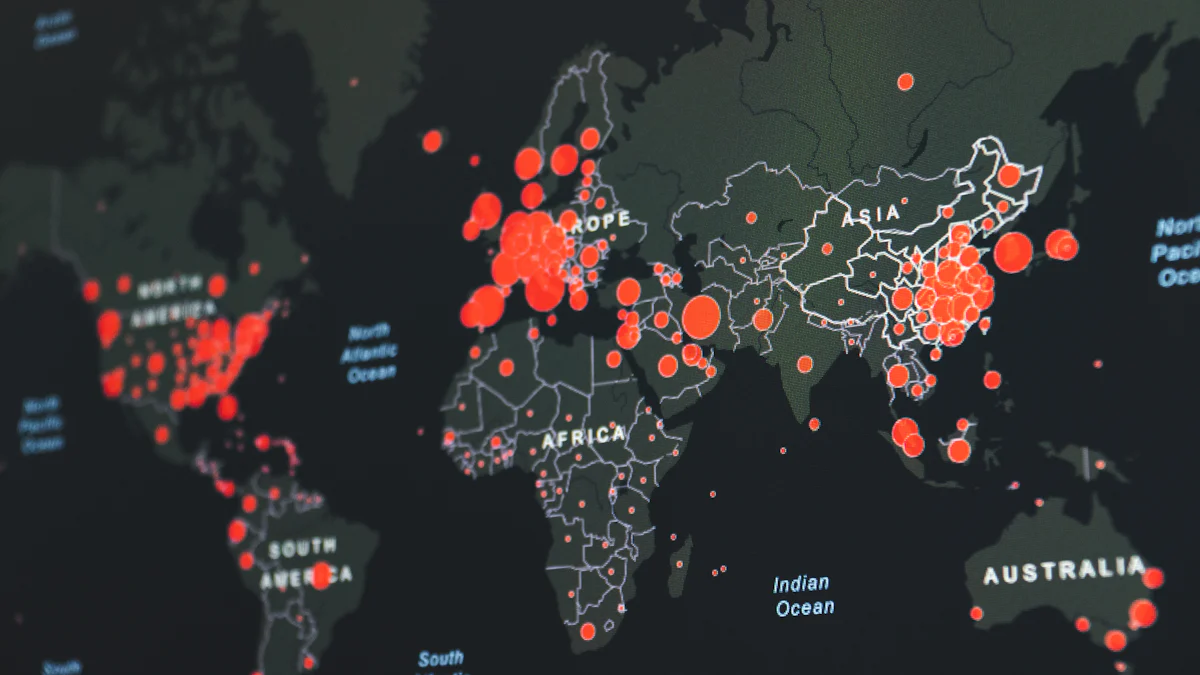Future Outlook and Analysis of the Global Logistics Market

The logistics market stands as a cornerstone of global trade, facilitating the movement of goods across borders. In 2022, the market reached a valuation of approximately $9,833.8 billion and is projected to soar to $16,794.7 billion by 2032. This growth trajectory underscores the critical need for comprehensive logistics industry analysis. Understanding future trends becomes imperative as technological advancements and globalization reshape the landscape. The logistics sector's expansion not only drives economic growth but also enhances supply chain efficiency, making it a pivotal area for strategic investment and innovation.
Logistics Industry Analysis
Current Market Trends
Technological Advancements
Technological advancements shape the logistics industry landscape. Innovations such as big data, IoT, and AI enhance operational efficiency. These technologies enable real-time tracking and predictive analytics. Companies leverage automation to streamline processes. Autonomous vehicles and drones revolutionize delivery systems. Blockchain technology ensures transparency and security in transactions.
E-commerce Influence
E-commerce significantly impacts the logistics market. The rise of online shopping increases demand for efficient logistics services. Consumers expect fast and reliable delivery. Retailers invest in advanced logistics solutions to meet these expectations. E-commerce growth drives the need for warehousing and distribution centers. The logistics industry adapts to handle higher volumes of small parcel shipments.
Market Drivers
Globalization
Globalization acts as a catalyst for logistics industry growth. Cross-border trade expands as companies seek international markets. Efficient logistics networks facilitate global supply chain operations. Businesses rely on logistics providers to navigate complex customs regulations. The demand for seamless transportation solutions increases with globalization.
Consumer Demand
Consumer demand influences logistics industry trends. Customers prioritize convenience and speed in delivery services. Personalized and flexible shipping options become essential. The logistics sector invests in last-mile delivery solutions. Companies focus on enhancing customer experience through efficient logistics operations. The growing middle class in emerging markets boosts consumer demand.
Market Challenges
Supply Chain Disruptions
Supply chain disruptions pose significant challenges to the logistics industry. Natural disasters, geopolitical tensions, and pandemics impact operations. Companies face difficulties in maintaining inventory levels. Logistics providers implement contingency plans to mitigate risks. The industry invests in resilient supply chain strategies to ensure continuity.
Regulatory Issues
Regulatory issues affect logistics industry dynamics. Compliance with international trade regulations requires expertise. Changes in environmental policies influence transportation practices. Companies must adapt to evolving regulatory frameworks. The logistics sector invests in sustainable practices to meet regulatory standards. Navigating complex regulations remains a priority for industry players.
Market Segmentation
By Mode of Transport
Road Transport
Road transport plays a crucial role in the logistics industry. Trucks and other vehicles provide flexible and cost-effective solutions for short to medium distances. The infrastructure for road transport continues to expand, enhancing connectivity between urban and rural areas. Companies invest in advanced fleet management systems to optimize routes and reduce fuel consumption. Road transport adapts to changes in consumer demand and regulatory requirements.
Air Freight
Air freight offers rapid delivery for high-value and time-sensitive goods. Airlines collaborate with logistics providers to ensure efficient cargo handling. The logistics industry analysis highlights the importance of air freight in global supply chains. Technological advancements improve tracking and security measures for air shipments. Air freight faces challenges such as fluctuating fuel prices and environmental concerns.
Sea Freight
Sea freight remains a cornerstone of international trade. Ships transport large volumes of goods across continents. Ports invest in modern facilities to accommodate increasing cargo traffic. The logistics industry analysis emphasizes the significance of sea freight for cost-effective long-distance transportation. Shipping companies adopt sustainable practices to minimize environmental impact. Sea freight encounters challenges like port congestion and geopolitical tensions.
By End-User Industry
Retail
The retail sector relies heavily on efficient logistics operations. Retailers demand timely delivery to meet consumer expectations. Warehousing and distribution centers support the flow of goods from manufacturers to stores. The logistics industry analysis reveals the growing importance of e-commerce in retail logistics. Companies implement advanced inventory management systems to enhance efficiency. Retail logistics adapts to seasonal fluctuations and promotional events.
Manufacturing
Manufacturing industries depend on robust logistics networks. Efficient supply chain management ensures the timely delivery of raw materials and finished products. The logistics industry analysis identifies manufacturing as a key driver of logistics demand. Manufacturers collaborate with logistics providers to optimize production schedules. Advanced technologies enable real-time monitoring of supply chain activities.
Healthcare
The healthcare industry requires specialized logistics solutions. Medical supplies and pharmaceuticals demand precise handling and storage conditions. The logistics industry analysis underscores the critical role of logistics in healthcare delivery. Companies invest in temperature-controlled transportation and warehousing facilities. Healthcare logistics face challenges such as regulatory compliance and product safety.
Regional Analysis

North America
Market Size and Growth
North America's logistics market reached a value of USD 433,251.42 million in 2021. The region is expected to experience significant growth in the coming years. A well-developed infrastructure supports this growth. Rail and road connectivity enhance logistics operations. The United States plays a pivotal role in this market. A comprehensive supply chain network connects consumers and producers. Various transportation modes, including express delivery and air services, contribute to market expansion.
Key Trends
E-commerce significantly influences North America's logistics sector. The rise of online shopping drives demand for efficient logistics solutions. Third-party service providers manage shipping for e-commerce businesses. These businesses focus on marketing and other operations. The logistics industry analysis highlights the importance of seamless supply chain management. Companies invest in advanced technologies to meet consumer expectations. The logistics sector adapts to rapid changes in consumer behavior.
Europe
Market Size and Growth
Europe's logistics market demonstrates steady growth. The region benefits from a robust transportation network. Rail, road, and maritime routes facilitate efficient logistics operations. European countries invest in modern infrastructure. These investments support the logistics industry's expansion. The logistics industry analysis reveals Europe's focus on sustainability. Companies adopt eco-friendly practices to reduce environmental impact.
Key Trends
Sustainability initiatives shape Europe's logistics landscape. Companies prioritize reducing carbon emissions. Green logistics solutions gain popularity among industry players. The logistics industry analysis emphasizes the importance of technology. Digitalization improves supply chain visibility and efficiency. European logistics providers leverage data analytics for better decision-making. The region's commitment to innovation drives continuous improvement.
Asia-Pacific
Market Size and Growth
Asia-Pacific's logistics market exhibits rapid growth. The region's market was valued at approximately $3,952.34 billion in 2023. A high CAGR of 10.45% is expected over the forecast period. Emerging economies contribute to this growth. Infrastructure development enhances logistics capabilities. The logistics industry analysis highlights Asia-Pacific's potential for expansion. Companies capitalize on opportunities in this dynamic market.
Key Trends
Technological advancements drive Asia-Pacific's logistics sector. Automation and IoT improve operational efficiency. The logistics industry analysis underscores the region's focus on innovation. Companies invest in smart logistics solutions. Real-time tracking and predictive analytics enhance supply chain management. Asia-Pacific's logistics providers adapt to changing consumer demands. The region's growth trajectory presents numerous opportunities for industry players.
Competitive Landscape

Key Players
JUSDA's Role in the Global Logistics Market
JUSDA Supply Chain Management International Co., Ltd. plays a pivotal role in the global logistics market. The company provides comprehensive end-to-end supply chain solutions. JUSDA integrates raw material procurement, manufacturing, and distribution. The company excels in lean supply chain management. Advanced technologies such as big data, IoT, and cloud platforms support complex customer demands. JUSDA's JusLink platform offers real-time collaborative platforms and intelligent supply chain systems. This system enables efficient resource utilization and precise business decision-making.
Company Profiles
Several key players dominate the logistics industry. DHL leads the global freight forwarding market. The company emphasizes efficiency and sustainability. Kuehne + Nagel holds a significant market share in the logistics industry. The company is recognized for its efficient transportation and supply chain networks. DB Schenker operates globally with an innovative approach to cross-border logistics. The company focuses on sustainability practices. FedEx dominates the North American logistics market. The company focuses on technological advancements and sustainability. UPS (United Parcel Service) emphasizes technological advancements and sustainability. The company caters to the increasing demand for efficient logistics services. Maersk is known for its global presence and efficient logistics solutions. The company holds a substantial market share in the forward logistics segment. C.H. Robinson Worldwide, Inc. offers a wide range of logistics services. The company actively engages in acquisitions, product launches, and partnerships.
Market Share Analysis
The logistics market features intense competition among key players. Companies strive to enhance their market position. DHL and Kuehne + Nagel maintain strong footholds in the global logistics market. FedEx and UPS lead in North America. Maersk holds a significant share in the forward logistics segment. C.H. Robinson Worldwide, Inc. expands its market presence through strategic initiatives. JUSDA's innovative platforms and global network contribute to its competitive advantage.
Recent Developments
Mergers and Acquisitions
Mergers and acquisitions shape the logistics industry's landscape. Companies pursue strategic acquisitions to expand their capabilities. C.H. Robinson Worldwide, Inc. actively engages in acquisitions. These initiatives enhance the company's market position. Other key players also explore mergers and acquisitions. These strategies drive growth and innovation in the logistics market.
Strategic Partnerships
Strategic partnerships play a crucial role in the logistics industry. Companies collaborate to enhance their service offerings. Partnerships enable access to new markets and technologies. JUSDA collaborates with suppliers, manufacturers, and service providers. These collaborations optimize supply chain operations. Other key players also form strategic partnerships. These alliances strengthen their competitive position in the logistics market.
The global logistics market continues to evolve, driven by technological advancements and the rise of e-commerce. The sector plays a pivotal role in facilitating trade across industries and regions. Businesses investing in new technologies set new standards in efficiency and sustainability. The North American market anticipates robust growth due to these factors. European nations focus on research and development, enhancing their logistics capabilities. The industry's resilience is evident as it adapts to changing consumer demands and economic shifts. Opportunities abound for those poised to innovate and lead in this dynamic landscape.
See Also
Unraveling the Effect: Trends in Logistics Risk
Tomorrow's Outlook on LTL Shipping: An Extensive Review
Artificial Intelligence in Logistics: Transforming Future Operations
Revealing the Definitive Handbook on Worldwide Logistics Firms
Insights into Ocean Freight Logistics: Latest Updates for 2024
